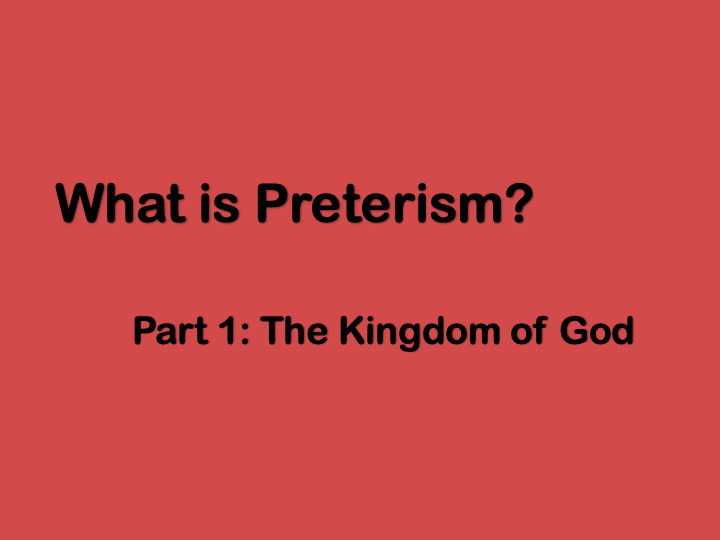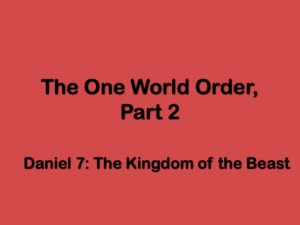What is Preterism? Part 1
In a previous post, we introduced two competing schools of end times interpretation: preterism and futurism. Preterism argues that most, if not all, end-times prophecies were fulfilled in the past, around the destruction of Rome in 70 AD. Futurism argues that most end-times prophecies will be fulfilled at some time in the future. In this post, we dive deeper into preterism.

The Imminency of the Kingdom of God
Preterism is one of the two major schools of interpretism of Biblical end-times property. Preterism places most of the events of the end-times in the past. In other words, preterism teaches that we are living in a world that is post the End of Days.
What does Preterism Mean?
The word preterism comes from the Latin Praeter, which means past. Preterist teaches that Biblical end-times are in the past. In other words, most Biblical prophecy has already been fulfilled.
The foundational arguments for preterism tend to be build on the following premises:
- Jesus promised that his second coming (Parousia) would occur within the generation that lived during the time of his ministry.
- The Olivet Discourse tied the Parousia to the fall of Jerusalem, which occurred in 70 AD.
- Revelation promised the prophecies would be fulfilled soon.
- New Testament authors expected the Parousia to occur soon.
During his ministry, Jesus made many statements that suggested the Kingdom of God was near, or the time that God would rule on earth was near. Therefore, preterists place a great deal of emphasis on the imminency of the Kingdom of God. They argue that unless Jesus was a false prophet, the Kingdom of Heaven must have started within the lifetime of the Apostles. However, while some end times prophecies, such as the destruction of the temple, were fulfilled within the lifetime of the Apostles, many were not. This forces preterists to apply a symbolic or figurative fulfilment to these prophecies. Futurists, on the other hand, place a greater weight on the literal fulfillment of prophecy, which forces them to place the Kingdom of Heaven sometime in the future, despite Jesus’ statements about its imminency.
Futurism differs from preterism in that they place a greater emphasis on the literal fulfillment of prophecy, which forces them to apply a symbolic or partial fulfillment interpretation to the imminency of the Kingdom of God.
The Second Coming (Parousia)
During his ministry, Jesus told his followers that he would come a second time. This was a unexpected revelation. In the Old Testament two contrasting pictures of the Messiah are given. One, sometimes known as the Suffering Servant, was destined to reconcile Israel and mankind with God. The other, sometimes known as the Lion of Judah, would return to judge the wicked and physically rule on earth. Jesus taught in his ministry that he had been born as a man to fulfill the role of the Suffering Servant. After his death and resurrection, he would return a second time as the Lion of Judah. This second coming, known as the Parousia from the Greek word for coming or presence, would be fulfilled at a future time.
Most Jews at the time of Jesus expected the Messiah to come as the Lion of Judah. They believed he would free Israel from the oppression of the Romans before establishing his own, righteous kingdom. The revelation that there would be two comings of the Messiah was a shock to Jesus’ disciples. That the second coming would not occur until after the death and resurrection was not clearly apparent from the Old Testament, but, in retrospect, this sequence of events did explain many confusing passages.
But Jesus did given hints that the second coming was very near. In Mathew, chapter 10, Jesus sends his disciples out into the cities of Israel to preach the gospel. Before sending them, he gives them advice and ends his advice with a prediction.
Brother will deliver up brother to death, and the father his child. Children will rise up against parents, and cause them to be put to death. You will be hated by all men for my name’s sake, but he who endures to the end will be saved. But when they persecute you in this city, flee into the next, for most certainly I tell you, you will not have gone through the cities of Israel, until the Son of Man has come.
Matthew 10: 21-23
Jesus seems to be promising the Son of Man, a reference to the Messiah, would come before the disciples had finished spreading the gospel. This is a little confusing, because Jesus was the Messiah. It is unclear if he is talking about the Second Coming or about something else.
We get a little more information in Matthew, chapter 16. Jesus gives an admonition to his disciples and finishes with a prophecy. Jesus tells his disciples that some of them will not die before they see the Kingdom of Heaven.
Then Jesus said to his disciples, “If anyone desires to come after me, let him deny himself, and take up his cross, and follow me. For whoever desires to save his life will lose it, and whoever will lose his life for my sake will find it. For what will it profit a man, if he gains the whole world, and forfeits his life? Or what will a man give in exchange for his life? For the Son of Man will come in the glory of his Father with his angels, and then he will render to everyone according to his deeds. Most certainly I tell you, there are some standing here who will in no way taste of death, until they see the Son of Man coming in his Kingdom.
Matthew 16: v24-28
Here the meaning is clearer. Jesus seems to clearly state that the Messiah will come to usher in his kingdom within the lifetime of the disciples. Jesus gives even more information in a famous sermon known as the Olivet Discourse.
The Olivet Discourse
The Olivet Discourse is a speech that Jesus gives to his disciples on the Mount of Olives, a hill that overlooks the temple in Jerusalem. The disciples were wondering at the splendor of the temple, and Jesus shockingly tells them the temple would soon be destroyed. The Olivet Discourse is recorded in all three synoptic gospels (Matthew 24-25, Mark 13, and Luke 21). In the discourse, Jesus gives the disciples signs of his second coming. Included in the signs is the destruction of Jerusalem and the Temple.
Jesus went out from the temple, and was going on his way. The disciples came to him to show him the buildings of the temple. But he answered them, “You see all of these things, don’t you? Most certainly I tell you, there will not be left here on stone on another, that will not be thrown down.”
As he sat on the Mount of Olives, the disciples came to him privately, saying, “Tell us, when will these things be? What is the sign of your coming, and of the end of the age?”
Jesus answered them, “Be careful that no one leads you astray. For many will come in my name, saying, ‘I am the Christ,’ and will lead many astray. You will hear of wars and rumors of wars. See that you aren’t troubled, for all this must happen, but the end is not yet. For nation will rise against nation, and kingdom against kingdom; and there will be famines, plagues, and earthquakes in various places. But all these things are the beginning of birth pains.
Matthew 24: 1-9
Jesus goes on to give may predictions for the time before his second coming, including oppression of the believers and an act known as the “abomination of desolation.” The entire chapter can be found here. He then follows the discourse with the parable of the fig tree. He tells his disciple the generation that sees the fig tree blossom will not pass away until they see the fulfillment of the prophecies in the Olivet Discourse.
Now from the fig tree learn this parable. When its branch has now become tender, and produces its leaves, you know that summer is near. Even so you also, when you see all these things, know that it is near, even at the doors. Most certainly I tell you, this generation will not pass way, until all these things are accomplished.
Matthew 24: 32-34
Again Jesus seems to promise that when the disciples see the signs he detailed (the fig tree blossoming), that generation will see the Second Coming before they die.
These are the key passages that preterists point to for the imminency of the Parousia and the Kingdom of Heaven. In part two, we’ll discuss the fall of Jerusalem in 70 AD and how these passages lead preterists to place key topic in end times at the fall of Jerusalem.







